One quality of financial advisors that I admire is that they are avid readers, always looking for the next bit of inspiration and insight to benefit their practices.
So when thinking about which books would most benefit financial advisors, I tried to mix best practices, aspirational goals, and issues that impact the industry but also transcend it.
I came up with a list of books from well-known industry leaders that speak practically about an RIA’s business and raise thought-provoking questions about the future of clients, investing and advisor culture.
I hope advisors will find all of them helpful -- and a good read!
The Enduring Advisory Firm
by: Mark Tibergien and Kimberly Dellarocca, Wiley/Bloomberg Press 2017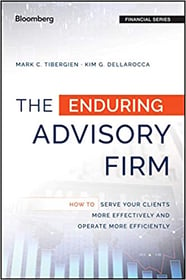 Tibergien is one of the financial advisory industry’s most respected thought leaders, and Dellarocca was a colleague and collaborator while they both worked at BNY Mellon. Tibergien, a frequently featured speaker at industry conferences, recently retired after nearly 13 years as CEO of Pershing Advisor Solutions, a leading RIA custodian and a BNY Mellon company.
Tibergien is one of the financial advisory industry’s most respected thought leaders, and Dellarocca was a colleague and collaborator while they both worked at BNY Mellon. Tibergien, a frequently featured speaker at industry conferences, recently retired after nearly 13 years as CEO of Pershing Advisor Solutions, a leading RIA custodian and a BNY Mellon company.
The Enduring Advisory Firm is an indispensable guide to running a state of the art RIA firm. Tibergien and Dellarocca review key business trends, the role of demographics, growth strategies, and how to transform an advisory practice into a business enterprise. The insights are keen, and the guidance comes from many years of observing and working with advisors in the trenches. And for an even more in-depth practice management dive, don’t miss Tibergien’s Practice Made (More) Perfect.
The Five Dysfunctions of a Team: A Leadership Fable
by: Patrick Lencioni, Wiley 2002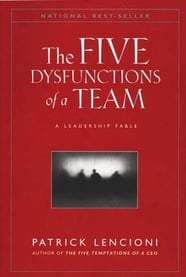 Lencioni is a best-selling business management expert whose books include The Five Temptations of a CEO and Death by Meeting.
Lencioni is a best-selling business management expert whose books include The Five Temptations of a CEO and Death by Meeting.
Teams have become table stakes for independent financial advisory firms. The era of the lone wolf broker and advisors in separate silos is over. But RIAs are still learning how to make teams function as efficiently as possible.
Lencioni lays out five common dysfunctions facing teams: the absence of trust, fear of conflict, lack of commitment, avoidance of team accountability, and inattention to team objectives.
He argues that confront team dysfunction calls for cultivating empathy, demanding debate, focusing on clarity, facing difficult issues, and focusing on outcomes.
But Five Dysfunctions isn’t written as a dry, managerial how-to. Instead, Lencioni presents a very readable fable about a fictional company facing real workplace issues and lessons learned. The book also includes a team assessment guide and suggested tools for dealing with issues that may be hampering teams.
It’s That Simple: How to Build the Professional Service Firm of the Future
by: Lawrence Miles, Dog Ear Publishing 2018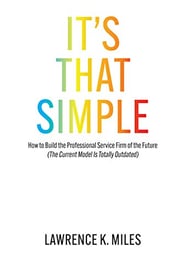 Miles, the CEO of Freestone Capital Management, is an industry veteran who has been a principal at AdvicePeriod and was the youngest regional president at BNY Mellon Wealth Management.
Miles, the CEO of Freestone Capital Management, is an industry veteran who has been a principal at AdvicePeriod and was the youngest regional president at BNY Mellon Wealth Management.
“It's past time that financial advisors treat their businesses as businesses,” Miles says. “Some of the best advisors I know, advisors whom I would recommend, are terrible business people. That needs to change.”
Miles emphasizes culture, recruiting, team building, client engagement, and technology as keys to improving client service. The bad news, he tells readers, is “if you think your business doesn’t need to change, you’re wrong. The good news is, it’s easier than you may think.”
So You Want to Talk About Race
by: Ijeoma Oluo, Basic Books 2019 Oluo is editor-at-large of The Establishment and a widely-read blogger.
Oluo is editor-at-large of The Establishment and a widely-read blogger.
People of color are severely under-represented in the financial advisory industry. According to the Department of Labor, black Americans make up less than 3% of advisors. While the industry has made strides in recruiting African Americans and improving the workplace environment, it still has a long way to go.
For executives who want to get up to speed on this critical issue, So You Want to Talk About Race is an excellent place to start. Oluo addresses such sensitive issues as privilege, microaggressions, intersectionality, and the Black Lives Matter movement. She tackles questions about race that are usually avoided and explains concepts that often elude Americans who may take their good fortune for granted.
Yes, the book may make for uncomfortable reading. But the issue demands no less. Just take a look around your own office — or any industry conference. Other books to consider are How to be an Antiracist by Ibram Kendi and White Fragility by Robin DiAngelo.
Advising the Ultra-Wealthy: A Guide for Practitioners
by: Gregory Curtis, Palgrave Macmillan 2020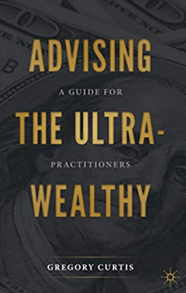 Curtis founded and heads Greycourt & Co., a 35-year old Pittsburgh-based multi-family office. He is a subject matter expert on ultra-high-net-worth clients and a prolific author, having written seven other books, including Family Capital and The Stewardship of Wealth, over 50 white papers, and a popular, long-running blog.
Curtis founded and heads Greycourt & Co., a 35-year old Pittsburgh-based multi-family office. He is a subject matter expert on ultra-high-net-worth clients and a prolific author, having written seven other books, including Family Capital and The Stewardship of Wealth, over 50 white papers, and a popular, long-running blog.
Advising the Ultra-Wealthy is aspirational as well as practical. Curtis acknowledges that for many advisors, attracting ultra-wealthy family clients can seem to be “an insurmountable hurdle.” Nonetheless, he maintains, “there are tried and true techniques that have worked for us over the years that can also work for you.”
Those techniques, including how to recruit wealthy clients, demonstrating intellectual capital, and cultivating COIs (centers of influence), are described in detail in chapter 4, “Building an Ultra-Wealthy Family Client Base.”
The other chapters tackle nitty-gritty aspects of working with ultra-high-net-worth clients, such as policy statements for wealthy families, governance, philanthropy, and how to evaluate money managers. An invaluable guide for navigating this complex and often little understood segment of the market.
Personal Financial Planning for Executives and Entrepreneurs
by: Michael Nathanson, Palgrave/Macmillan 2018 Nathanson is the longtime CEO of The Colony Group, one of the country’s leading RIAs. He collaborated with eight colleagues to offer a financial planning guide for corporate executives and independent business people — and advisors who work with them.
Nathanson is the longtime CEO of The Colony Group, one of the country’s leading RIAs. He collaborated with eight colleagues to offer a financial planning guide for corporate executives and independent business people — and advisors who work with them.
Personal Financial Planning lays out case studies and granular advice for high-net-worth clients dealing with investment, tax, estate, and philanthropy planning. Risk management, equity-based compensation, employment agreements, and insurance issues are also discussed.
The authors say Personal Financial Planning aims to “keep your attention and make sure that, by the end of this book, you have a strong sense of the power of effective, targeted financial planning.” They succeeded, and executives and advisors alike will benefit.
The Essential Advisor: Building Value in the Investor-Advisor Relationship
by: Bill Crager and Jay Hummel, Wiley 2016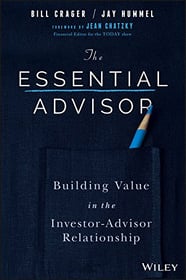 Crager is an acknowledged visionary who co-founded Envestnet and is currently CEO of the fintech giant. Hummel is the former COO of Lenox Wealth Management and is now a partner at Wealth Advisor Growth Network.
Crager is an acknowledged visionary who co-founded Envestnet and is currently CEO of the fintech giant. Hummel is the former COO of Lenox Wealth Management and is now a partner at Wealth Advisor Growth Network.
The Essential Advisor highlights how clients perceive financial services while laying out concrete framework advisors can use to enhance their value to clients. “The value proposition of many advisors will need to be communicated and built differently as the industry changes,” according to the authors.
Financial planning, asset allocation, investment selection, rebalancing, and tax management are the pillars of that value, Crager and Hummel argue. To maximize value, the authors urge advisors not to be afraid to talk about fees but to use the discussion “as an opportunity to deepen relationships and clarify expectations.”
The Art of M&A: Valuation and Modeling
by: Peter Nesvold, Elizabeth Bloomer Nesvold and Alexandra Reed Lajoux, McGraw-Hill 2016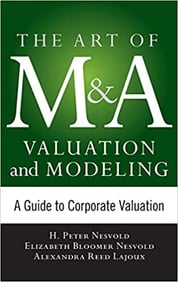 Peter Nesvold is an RIA M&A veteran who heads the merchant bank, Nesvold Capital Partners. Liz Nesvold ran the M&A consultancy and investment bank Silver Lane Advisors with Peter before joining Raymond James. Lajoux was the chief knowledge officer of the National Association of Corporate Directors for 11 years.
Peter Nesvold is an RIA M&A veteran who heads the merchant bank, Nesvold Capital Partners. Liz Nesvold ran the M&A consultancy and investment bank Silver Lane Advisors with Peter before joining Raymond James. Lajoux was the chief knowledge officer of the National Association of Corporate Directors for 11 years.
RIAs continue to be bought and sold in record numbers, despite a global pandemic. Industry experts don’t expect the deal-making frenzy to slow down any time soon, so the more informed advisory owners are about the M&A process, the better off they are.
The Art of M&A explains the fundamentals of valuing a business, the difference between price and value, contingent consideration, and how to use tax structures and forecast scenarios. It also addresses the critical question for every buyer and seller — what’s a business worth? — and provides a framework for arriving at an appropriate answer.
The Incredible Shrinking Alpha: And What You Can Do to Escape Its Clutches
by: Larry Swedroe and Andrew Berkin, Harriman House 2020 (second edition) Swedroe is the high-profile chief research officer for Buckingham Strategic Wealth, author of the bestselling series of The Only Guide investment books, and a frequent guest on CNBC, CNN, and Bloomberg. Berkin is the director of research at Bridgeway Capital Management.
Swedroe is the high-profile chief research officer for Buckingham Strategic Wealth, author of the bestselling series of The Only Guide investment books, and a frequent guest on CNBC, CNN, and Bloomberg. Berkin is the director of research at Bridgeway Capital Management.
The Incredible Shrinking Alpha focuses on a hard truth that advisors know but too often tend to forget: chasing alpha as an active investor is a losing game.
Swedroe and Berkin combine compelling data from academic research with plain-speaking common sense to warn advisors and clients away from chasing returns that are tempting but illusory. Over time, the authors argue, alpha returns have morphed into beta, and the advantages of high-powered institutional managers over individual investors have grown.
The Incredible Shrinking Alpha sometimes confuses correlation with causation and spends little time on how investors can maximize real returns over time. But overall, the book’s message resonates: accept market returns in the asset classes or factors that are best suited to an investor’s needs and discover what life has to offer beyond the quest for alpha.
How I Invest My Money: Finance Experts Reveal How They Save, Spend and Invest
Edited by: Josh Brown and Brian Portnoy, Harriman House 2020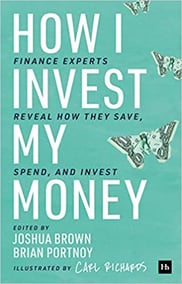 Brown is CEO of Ritholtz Wealth Management and well-known as The Reformed Broker blogger and a frequent CNBC commentator. Portnoy is the founder of Shaping Wealth, a financial wellness platform, and author of several behavioral finance books.
Brown is CEO of Ritholtz Wealth Management and well-known as The Reformed Broker blogger and a frequent CNBC commentator. Portnoy is the founder of Shaping Wealth, a financial wellness platform, and author of several behavioral finance books.
Financial advisors help clients construct their portfolios, but how do they invest their own money? That’s what Brown and Portnoy set out to find out, and the responses provide valuable insights into how advisors not only think about asset management but they approach money as part of their lives.
The editors reveal their investing habits, and other respondents from the RIA world include Dynasty Financial Partners CEO Shirl Penney.
Paradoxically, investment strategies, while included, aren’t the point of the book. How to successfully integrate money in one’s life to achieve happiness is the real recurring theme – even if the decisions don’t necessarily bring the highest monetary returns.
For example, Portnoy discusses his decision to pay off his mortgage. He acknowledges that it may not have been the optimal financial decision. Nevertheless, he says, “I don’t care.” Why? Because he enjoys living without debt, and that’s reason enough.
AdvisorEngine’s wealth management platform helps
advisors who want to grow and scale by automating operational
pain points and elevating the client experience.
This blog is sponsored by AdvisorEngine Inc. The information, data and opinions in this commentary are as of the publication date, unless otherwise noted, and subject to change. This material is provided for informational purposes only and should not be considered a recommendation to use AdvisorEngine or deemed to be a specific offer to sell or provide, or a specific invitation to apply for, any financial product, instrument or service that may be mentioned. Information does not constitute a recommendation of any investment strategy, is not intended as investment advice and does not take into account all the circumstances of each investor. Opinions and forecasts discussed are those of the author, do not necessarily reflect the views of AdvisorEngine and are subject to change without notice. AdvisorEngine makes no representations as to the accuracy, completeness and validity of any statements made and will not be liable for any errors, omissions or representations. As a technology company, AdvisorEngine provides access to award-winning tools and will be compensated for providing such access. AdvisorEngine does not provide broker-dealer, custodian, investment advice or related investment services.




